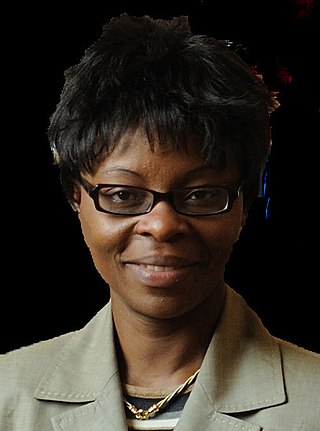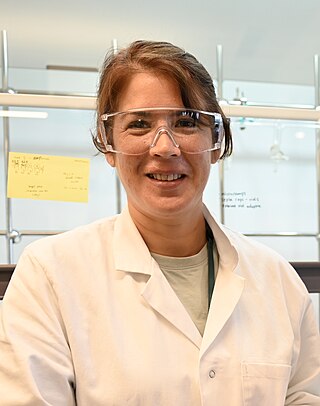Stuart Alan Rice was an American theoretical chemist and physical chemist. He was well known as a theoretical chemist who also performed experimental research, having spent much of his career working in multiple areas of physical chemistry. He was the Frank P. Hixon Distinguished Service Professor at the University of Chicago. During his tenure at the University of Chicago, Rice trained more than 100 Ph.D. students and postdoctoral researchers. He received the National Medal of Science in 1999.

Corannulene is a polycyclic aromatic hydrocarbon with chemical formula C20H10. The molecule consists of a cyclopentane ring fused with 5 benzene rings, so another name for it is [5]circulene. It is of scientific interest because it is a geodesic polyarene and can be considered a fragment of buckminsterfullerene. Due to this connection and also its bowl shape, corannulene is also known as a buckybowl. Buckybowls are fragments of buckyballs. Corannulene exhibits a bowl-to-bowl inversion with an inversion barrier of 10.2 kcal/mol (42.7 kJ/mol) at −64 °C.
Jing Li is a Board of Governors Professor of Chemistry and Chemical Biology at Rutgers University, New Jersey, United States. She and her team are engaged in solid-state, inorganic and inorganic-organic hybrid materials research. Her current research focuses on designing and developing new functional materials including metal-organic frameworks and hybrid semiconductors for applications in the field of renewable and sustainable energy, and clean environment.
Angela K. Wilson is an American scientist and former (2022) President of the American Chemical Society. She currently serves as the John A. Hannah Distinguished Professor of Chemistry, associate dean for strategic initiatives in the College of Natural Sciences, and director of the MSU Center for Quantum Computing, Science, and Engineering (MSU-Q) at Michigan State University.

Kenneth D. Karlin was born on October 30, 1948, in Pasadena, California, a professor of chemistry at Johns Hopkins University in Baltimore, Maryland. Research in his group focuses on coordination chemistry relevant to biological and environmental processes, involving copper or heme complexes. Of particular interest are reactivities of such complexes with nitrogen oxides, O2, and the oxidation of substrates by the resultant compounds. He is also the Editor-in-Chief of the book series Progress in Inorganic Chemistry.

Geraldine Lee Richmond is an American chemist and physical chemist who is serving as the Under Secretary of Energy for Science in the US Department of Energy. Richmond was unanimously confirmed by the United States Senate to her role on November 5, 2021. In this position, she oversees the Office of Science, the Applied Energy offices, and 13 of the 17 Department of Energy national laboratories. Before this appointment, Richmond served as a Professor of Physical Chemistry and held the Presidential Chair in Science at the University of Oregon. Her research has focused on understanding the chemistry and physics of complex surfaces and interfaces, using laser-based experimental and theoretical computational methods. These understandings are most relevant to energy production, atmospheric chemistry and remediation of the environment. Throughout her career she has also worked to increase the number and success of women scientists in the U.S. and in many developing countries through the COACh program that she founded in 1999. She is a member of the National Academy of Sciences and the American Academy of Arts and Sciences. In recognition of her scientific achievements and contributions to women in science, she received the National Medal of Science from President Obama in 2013.

Judith P. Klinman is an American chemist, biochemist, and molecular biologist known for her work on enzyme catalysis. She became the first female professor in the physical sciences at the University of California, Berkeley in 1978, where she is now Professor of the Graduate School and Chancellor's Professor. In 2012, she was awarded the National Medal of Science by President Barack Obama. She is a member of the National Academy of Sciences, American Academy of Arts and Sciences, American Association for the Advancement of Science, and the American Philosophical Society.

Omowunmi "Wunmi" A. Sadik is a Nigerian professor, chemist, and inventor working at New Jersey Institute of Technology. She has developed microelectrode biosensors for detection of drugs and explosives and is working on the development of technologies for recycling metal ions from waste, for use in environmental and industrial applications. In 2012, Sadik co-founded the non-profit Sustainable Nanotechnology Organization.

Debbie C. Crans is a Professor of Organic, Inorganic and Biological Chemistry and of Cell and Molecular Biology at Colorado State University, where she also is a Professor Laureate of the College of Natural Sciences. Crans specializes in the fundamental chemistry and biochemistry of drugs, with particular focus on vanadium and other transition metal ions as metals in medicine and investigation of their mechanisms of toxicity.
Elizabeth Marie Nolan is an American chemist and associate professor at Massachusetts Institute of Technology.
Stephanie Lee Brock is an American chemist who is professor of inorganic chemistry at Wayne State University. Her research considers transition metal pnictides and chalcogenide nanomaterials. She is a Fellow of the American Association for the Advancement of Science and the American Chemical Society.
Heather J. Kulik is an American computational materials scientist and engineer who is the Lammot Du Pont Professor of Chemical Engineering at the Massachusetts Institute of Technology. Her research considers the computational design of new materials and the use of artificial intelligence to predict material properties.
Kristin Susan Bowman-James is an American chemist who is a distinguished professor at the University of Kansas. Her research makes use of host–guest chemistry to design new molecules for biology and the environment. She was awarded the 2021 American Chemical Society Award in Inorganic Chemistry.
Anastassia N. Alexandrova is an American chemist who is a professor at the University of California, Los Angeles. Her research considers the computational design of functional materials.
Connie C. Lu is a Taiwanese-American inorganic chemist and a professor of chemistry at the University of Bonn. She was previously a professor of chemistry at the University of Minnesota, Twin Cities. Lu's research focuses on the synthesis of novel bimetallic coordination complexes, as well as metal-organic frameworks. These molecules and materials are investigated for the catalytic conversion of small molecules like as N2 and CO2 into value-added chemicals like ammonia and methanol. Lu is the recipient of multiple awards for her research, including the National Science Foundation CAREER Award and the Sloan Research Fellowship in 2013, and an Early Career Award from the University of Minnesota's Initiative for Renewable Energy and the Environment in 2010.

Christine Luscombe is a Japanese-British chemist who is a professor at the Okinawa Institute of Science and Technology. Her research investigates polymer chemistry, organic electronics, organic photovoltaics and the synthesis of novel materials for processable electronics. She serves on the editorial boards of Macromolecules, Advanced Functional Materials, the Annual Review of Materials Research and ACS Applied Materials & Interfaces.
Alexander M. Spokoyny is an American chemist and a professor in chemistry and biochemistry at UCLA and a faculty member of the California NanoSystems Institute (CNSI). He is currently a department chair of Chemistry and Biochemistry at UCLA.
Jennifer Ann Prescher is an American chemist who is a professor of chemistry at the University of California, Irvine. Her research considers the development of bioorthogonal, bioluminescent tools for the noninvasive, real-time imaging of immunometabolism. She was recognized with the 2023 American Chemical Society Arthur C. Cope Scholar Award.
Amanda Morris is an American chemist who is the Patricia Caldwell Faculty Fellow and professor of inorganic and energy chemistry at Virginia Tech. Her research considers next-generation materials for catalysis and light-harvesting. She was elected chair of the American Chemical Society Gay and Transgender Chemists and Allies committee in 2021.
Claudia Turro is an American inorganic chemist who is the Dow Professor of Chemistry at The Ohio State University (OSU). Since July 2019 she has been the Chair of the OSU Department of Chemistry and Biochemistry. She was elected Fellow of the American Chemical Society in 2010 and is a member of the American Academy of Arts and Sciences (2023) and the National Academy of Sciences (2024).






